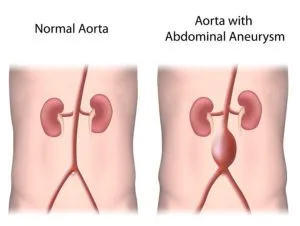Screening for Abdominal Aortic Aneurysm

Should you consider getting a screening for an abdominal aortic aneurysm (AAA)? Yes you should. According to the Centers for Disease Control and Prevention (CDC), aortic aneurysms or aortic dissections (tears) were the cause of 9,904 deaths in 2019. If an aneurysm ruptures, it’s very unlikely that the person will survive long enough to have it repaired.
What Is an Aortic Aneurysm?
An aortic aneurysm is a balloon-like bulging of the wall of your aorta, the main artery that carries blood from the heart to the rest of your body. An aneurysm may grow over time. The larger the aneurysm becomes, the greater the chance of rupture or bursting.
Aneurysms may develop for several reasons. Most aortic aneurysms are caused by a breakdown in the proteins that provide structural strength to the wall of the aorta.
- Cigarette smoking is the leading cause of the development and growth of an aneurysm. The CDC notes that a history of smoking accounts for about 75% of all abdominal aortic aneurysms.
- Family history of AAA may also be a factor.
- Individuals over 60 years are most likely to develop the condition.
- Males are more prone to the condition than females.
- A history of atherosclerosis (hardening of the arteries), high blood pressure and chronic lung disease can increase risk.

Who Should Be Screened?
The U.S. Preventive Services Task Force recommends screening for the following groups:
- Men aged 65 to 75 years who have smoked 100 or more cigarettes in their lives
- Men aged 65 to 75 years who have a family history of AAA
- Women aged 65 to 75 years who have a family history of AAA
What Does a Screening for Abdominal Aortic Aneurysm Involve?
Abdominal duplex ultrasonography is the standard approach for AAA screening. This is a painless and noninvasive evaluation of blood flow through your arteries and veins. It takes about 30 minutes and uses both traditional ultrasound and Doppler ultrasound. The doctor can look at an image of your abdomen and the speed and direction your blood flows.
Medicare Screening Benefit
Medicare Part B (medical insurance) covers an abdominal aortic screening ultrasound once in your lifetime if you’re at risk. You’re considered at risk if you have a family history of abdominal aortic aneurysms, or you’re a man 65 to 75 and have smoked at least 100 cigarettes in your lifetime. You pay nothing for this test if the doctor or other qualified health care provider accepts the assignment.
Always ask questions so you understand why your doctor recommends certain services and if or how much Medicare will pay for them.
When Does an Aneurysm Need to Be Fixed?
There are many factors that determine when an aneurysm needs to be fixed. In deciding whether to recommend repair, your surgeon will consider the location of your aneurysm, its size and shape, how fast it’s growing, how complicated it is to repair, and your overall health. If the estimated risk of your aneurysm rupturing is greater than the risk of surgery, your surgeon will recommend repair. Repairs can be done using a minimally invasive method or open surgery method.
For more information on aortic aneurysms and treatments, visit the Center for Complex Aortic Disease at UMass Memorial Health. Locations:
- Worcester: 508-856-5599
- Charlton: 508-248-8105
Other related articles by:
AAA | Abdominal Aortic Aneurysm | aortic aneurysm | heart | screening | smokingNote: The content of this blog is for informational purposes only. It is not intended for use as diagnosis or treatment of a health problem or as a substitute for the professional consultation of a physician or qualified health care provider. If you have specific questions or concerns regarding a health or medical condition, contact your physician or a licensed health care professional.

